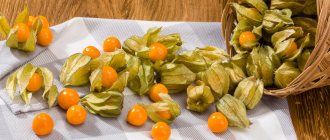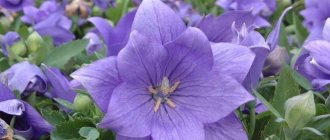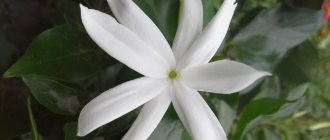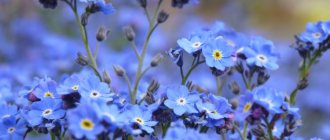Description and preparation
The red slipper has a fragile root system, an erect stem up to 45 cm tall and wide leaves with pointed edges. In May-June (once every two years), the slipper blooms with bright red flowers - at the end of the stem there is one flower with large bracts. The shape of the flower resembles a shoe. The stems and leaves of red slipper are used as medicinal raw materials. Harvesting is done during the flowering period of the plant - May-July: the stems and leaves are carefully cut off, trying not to damage the root system, otherwise the shoe will die.
Dry the slipper grass outdoors under a canopy, avoiding direct sunlight, or in an electric dryer at a temperature of 40C.
During the natural drying process, the raw materials need to be turned over every three days. Harvested raw materials are stored in fabric bags or paper bags for 1 year.
Sometimes the roots of the plant are used for medicinal purposes.
Paphiopedilum: home care
If properly planted and cared for, the slipper orchid can be grown at home. If you plan to plant the plant in the ground, it should be in a shaded place. In the case of an apartment flower garden, you should choose a fairly wide pot or flowerpot, since the root system of paphiopedilums is horizontal.
Reo flower: examples of flower care at home
Classic home care for any flowers usually includes frequent treatment of the plant against pests and disease prevention. But the lady's slipper is practically not susceptible to diseases of ordinary indoor plants, and they only need to be protected from spider mites (the absence of which is ensured by ordinary regular care of the flower).
Important conditions for growing lady's slipper:
- lighting. These flowers are shade-loving. Direct sunlight should be avoided even in winter. If the orchid is kept in an apartment, it can be placed in the back of the room away from the window, provided there is uniform artificial lighting. For an outdoor flower bed, a place under a spreading tree or in the constant shade of a building is suitable;
- air temperature and humidity. The universal temperature regime for growing lady's slippers during the main period is 18-25°C, in winter - no less than 10°C, in summer - no more than 33°C. The air should be of high humidity, that is, regular spraying of the flower is recommended, especially in the hot season;
- watering. The substrate (or soil) should never dry out; the plant should be watered especially abundantly in the summer. It is better to settle the water so that it reaches room temperature. Moisture should not fall on the base of the stem, otherwise it will rot;
- soil and fertilizing. The ideal option in the case of orchid flowers would be a substrate containing moss, pieces of bark, and charcoal. Large particles should be at the bottom of the container or hole, fine substrate should be higher. Fertilizing is carried out in all seasons except winter once every two weeks with the usual complex mineral fertilizer.
Important! Reddening of the leaves of the lady's slipper often signals that there is too much light for it and it should be shaded.
You shouldn't place a lady's slipper right next to the window.
It is worth remembering that in garden and indoor conditions, different types of orchids may feel differently. There are more heat-loving flowers that will not bloom outside, and there are more resistant to weather conditions. For the garden, it is worth choosing those varieties of lady's slippers that grow naturally in the planting region.
For wintering, it is important to cover the planting site of the lady's slipper with dry straw or pieces of foam plastic or other insulating material. In this case, the plant should not be exposed to strong winds.
Lady's slipper goes well with other garden flowers
Composition and properties
Red slipper contains: ascorbic acid, tannin, resinous substances, alkaloids, calcium oxalate and essential oils. Thanks to its composition, red slipper has anti-inflammatory, diuretic and soothing effects. In folk medicine, the red shoe is used for:
- fever;
- malaria;
- decreased appetite;
- gastritis;
- umbilical hernia;
- high blood pressure;
- cardiovascular diseases;
- nervous system disorders;
- headache, migraine;
- sleepwalking;
- depression;
- epilepsy;
- schizophrenia
- insomnia;
- fainting;
- uterine bleeding;
- absence of menstruation;
- swelling.
- 5 pieces. red slipper leaves;
- 1 tbsp. boiling water
Pour boiling water over the leaves and let sit until cool. Strain the infusion. Take 1 dessert spoon.
- 1 red slipper plant;
- 1 tbsp. boiling water
This infusion has a calming effect and also helps with epilepsy and headaches. Take a whole plant - with roots and leaves - and pour boiling water over it. Let it brew for half an hour. Strain. Take 1 teaspoon three times daily before meals.
- 5 g of dry crushed red slipper herb;
- 1 tbsp. boiling water
Fill the shoe with boiling water in a thermos and let it brew for half an hour. Strain. Take 15 ml three times a day after meals. This drug can also be taken as a diuretic or laxative 5-6 times a day in the same dosage. This infusion will also help with uterine bleeding - you need to take it 50 ml at night.
- 1 tsp herbs (stems, leaves) red slipper;
- 1 tbsp. boiling water
Pour boiling water over the shoe and boil in a water bath for half an hour. Strain. Take 1 teaspoon three times a day. The decoction is recommended for decreased appetite, gastritis, lack of menstruation, umbilical hernia, and blood purification.
Disease and pest control
Among the causes of diseases of plants of the archid family, the main ones are:
- non-compliance with agrotechnical recommendations when planting;
- abundant regular watering, which promotes root rot;
- use of low-quality planting material (lack of initial visual inspection of the root system);
- carrying out procedures with planting material using non-disinfected instruments.
It is very simple to avoid such phenomena; it is enough to follow the exact conditions and requirements for the process of planting and further caring for flowers.
The most common pests that can “attack” plants of this type are:
- spider mite,
- aphid,
- snails,
- slugs,
- scale insects,
- mealy worm.
To combat them, there are many drugs, both chemical and biological. But to avoid causing harm to people and pets, experts still recommend using biological agents.
Frequently used ones include:
- vertilillin,
- bitoxybacillin-P,
- Bona Forte.
Contraindications
The red shoe is contraindicated for:
- pregnancy and breastfeeding;
- individual intolerance;
- allergic reactions.
Article on the topic: Cylindrical luffa - useful properties, description
Attention! Red shoe is a poisonous plant! Shoe treatment can only be started after consulting a doctor. Excessive dosage of medicines prepared on the basis of the lady's slipper can lead to depression of the nervous system.
- Meadow lumbago
Meadow lumbago or dream grass is a perennial herbaceous plant with large beautiful flowers of the Ranunculaceae family. Is poisonous. The lumbago is growing by...
Indian tamarind
Indian tamarind or Indian date is an evergreen tree of the Legume family. Grows in Africa, India, Australia, South Asia, Oceania. IN…
Saffron sativa
Saffron or Crocus sativum is a perennial corm plant of the Iris family. It grows in Central Asia, Azerbaijan, the North Caucasus, Crimea.…
Cedar elfin wood
The dwarf cedar or dwarf pine is a creeping, tree-like evergreen coniferous plant of the Pinaceae family. It grows as an undergrowth in coniferous forests, and...
Habitat and protection of the species
The true lady's slipper grows in marshy, shady places in forests with ancient perennial trees, on the banks of rivers and lakes. Prefers humus soil containing phosphorus, nitrogen, and potassium in an easily digestible form. Mostly distributed in deciduous forests, but also found in coniferous and small-leaved plantings.
In one place it grows in a group, sometimes of considerable size. It is very difficult for it to grow without the appropriate conditions developed by nature. Therefore, cutting down such forests will certainly cause a decrease in the population of this plant species, and ultimately may lead to its complete death.
If the felled areas are replanted with new seedlings over the course of 3 years, then the Lady’s slipper will be able to recover in this area. Otherwise, it will be lost forever.
Even minor forest fires, which often rage over vast areas during the hot season, are not as terrible for the lady’s slipper as cutting down trees. With rapid fire, plant rhizomes located at a depth of 4 cm in the soil are not exposed to it.
If after a fire even a small part of the tree stand remains, it actively produces new shoots from its dormant buds. There are known facts that on the burnt remains the “cuckoo shoes” grew even more.
Due to their extraordinary beauty, lady's slipper flowers, which begin to appear only after 15 years of development, are widely used by bouquet lovers. Not knowing the characteristics of this type of plant, people pluck them, depriving the roots of nutrition. After all, they simply cannot exist without the ground part.
If, after the onset of the flowering period, these flowers are picked every year, then after 3-4 years it will completely disappear, since all the replacement buds available in the crop will be used. And new ones will no longer be able to form without nutrition.
Slipper grandiflora, or lady's slipper
The first species of this plant were discovered in northeastern India, China and Vietnam. Afterwards the flower came to Europe, and only then to Russia. You can meet this interesting plant in Siberia and the Far East. The lady's slipper belongs to the orchid family and is a perennial herbaceous plant. The genus of this plant dates back more than 30 thousand years. It is impossible to keep an exact count of the varieties of the flower - this is due to the fact that some species are almost completely destroyed for commercial purposes, while others unexpectedly reappear in the wild. It is not for nothing that the large-flowered slipper plant has such a name - the shape of its flower is very reminiscent of a slipper. In addition, the flowers have a bright, attractive color and a very pleasant aroma.
Legends and interesting facts
The most interesting fact in the history of breeding and growing flowers of the archidae family is considered to be the experience of the director of the Imperial Botanical Garden in St. Petersburg. His name was E. L. Regel. He managed to grow the now extinct species of Canada slipper in humus-enriched corners of the garden located in the shade of trees.
Its charming white flowers with a slight pink tint were a real decoration of the surrounding greenery. But the essence of the exclusivity of the experiment was that the seeds of this type of flower could not grow without a special mycelium.
But, nevertheless, E. L. Regel managed to grow a plant that not only took root well in the harsh climate, but also tolerated the snowy St. Petersburg winters well. The achievement of this man was irretrievably lost, but modern experts hope not only to preserve existing species, but also to create new, more unpretentious and beautiful hybrids.
Currently, many flower lovers want to grow real lady's slippers in their flower beds. Since it grows safely together with other flowering plants, the composition created with its participation will become the best attraction of the garden. The main thing is not to neglect the basic recommendations of experts on growing and caring for this miracle of nature.
Types of shoe
There are quite a few species of this plant, but three main ones can be distinguished. The true lady's slipper is a plant with a horizontal rhizome, approximately 50 centimeters in height, leaves shaped like an ellipse, and an original flower. It begins to bloom in July. The next species is the grandiflora slipper. It is widely used to create hybrids, as it has several natural variations. Its flowers are very large, a standard one can reach 10 centimeters in diameter. Their color is usually bright pink, but the shoes can also be white or red.
This variety blooms a little earlier than the first type - in May. Another species is the spotted lady's slipper. Its flower is truly beautiful - white or pink, covered with dark purple spots. This is the rarest large-flowered slipper. The Red Book of the Russian Federation has taken under protection this endangered species.
How does pollination occur?
Having such a colorful and nectar-smelling device as a “planting” lip on a large flower, the lady’s slipper attracts a serious pollinating insect: an interesting natural symbiosis has developed with bees of the Andrena genus. Bees like that the flower contains a lot of nectar, and the flower has adapted to the fact that the hairy insect tolerates its pollen better than anyone else. After landing on the lip, the bee squeezes into the narrow passage of the flower, where it feasts on nectar, the base of the petals is slippery and the bee falls inside the flower, bathing in the nectar. A wet insect temporarily loses its ability to fly.
After several attempts to take off, the exhausted insect realizes that the only way to get out of the flower is by crawling. Seeing a small saving hole, which is located under two stamens, it begins to crawl out of its insidious captivity, and the petals of the lady's slipper, devoid of pigmentation in this place, show the insect the direction where it needs to crawl.
Climbing out through a narrow opening, the bee first touches the outlet stigma, leaving pollen brought from other flowers on it. Just before leaving, the bee touches two anthers, which sprinkle it with their pollen. Having reached the lip area, the insect cannot take off for some time, but having dried and rested slightly, the bee flies to the next lady's slipper, where the adventure is repeated again.
After fertilization, the orchid still retains its bright color for 2 - 4 days. An unpollinated lady's slipper can wait a month or more for its pollinator. Cut flowers last for about two weeks. The lady's slipper begins to bloom from mid-May to June.
What conditions are needed to grow slipper?
Since there are actually a lot of varieties of slippers, there are no uniform conditions for growing this flower. The only indispensable thing is that they should be as close as possible to natural growing conditions. Among the cypripediums there are plants adapted to different growing areas - these are orchids that grow on trees, and plants that are more comfortable on stones and rocks, there are also those that prefer simple humus. Therefore, it is very important to know which species is best suited. The soil in which the shoe is planned to be planted must certainly be moderately alkaline, moist and with good air filtration. These flowers love both sunlight and shaded areas.
Related article: False narcissus (yellow) - beneficial properties, description
But there is one more side that unites different subspecies of the slipper - almost all of them are frost-resistant.
The large-flowered slipper does not require special care - the plant is considered not at all whimsical. All that is required is regular, moderate watering. It is important to know that under no circumstances should you flood the soil. Just as you should not overdry it - the plant will certainly die in these cases. If the air is very dry, it is better to spray the shoe periodically or try to create conditions that will allow it to maintain moderate humidity. When the shoe blooms, it is worth feeding it. The best complementary food in this case would be mullein infusion. But you can’t overdo it with mineral fertilizers - they contribute to the formation of salts in the soil, which will also destroy the flower. So, we have partially examined the large-flowered slipper - description, types, care.
What else do you need to know about this plant?
Habitats and medicinal properties
In the plant world, orchids are called aristocrats: they are the most beautiful and mysterious, delicate and graceful flowers.
They mainly live in the tropics of the Earth, where a warm and humid climate prevails. But there are brave souls who grow and even bloom, despite the cold and snow, in the mountains. Not so long ago, the real lady’s slipper grew almost everywhere in the forests of Russia. The Red Book of 1984 claims that it could be found especially often near large rivers - the Volga, Kama, Dnieper, Don. Now orchids are disappearing catastrophically quickly. This is due to deforestation and bouquet lovers.
Need to know:
- lady's slipper is a bad choice for decorating a bouquet, because after picking it instantly withers;
- It is not suitable for animal food because its juice is poisonous. Only a sika deer can eat a flower without harming itself, but this animal also disappears with the same speed.
Whether the juice of the lady's slipper has medicinal properties is still not clear, because the plant has not yet been fully studied . You should probably be careful with this flower. It would not be amiss to recall the famous Shakespearean tragedy “Romeo and Juliet”:
Like this in this little flower:
Poison and medicine are in a delicate shell;
Smell it and you will gain strength,
But it's worth swallowing for it to kill.
A rare species of this orchid grows in Ukraine - the large-flowered slipper, also known as C. macranthon. People call it “red zozulka” or “red cuckoo” for the lilac-pink color of its petals.
In the Far East, in coniferous and mixed forests, you can sometimes find a spotted slipper, its lip is pockmarked due to merging pink spots .
Echinopsis: types, care and reproduction at home
This is interesting:
- Orchid seeds are among the smallest in the flora kingdom.
- For the seeds of the true lady's slipper to germinate, there must be a special mycelium in the soil; without this helper, the flowers will not grow. It supplies tender seeds at the very beginning of their growth with special nutrients.
- True, there was one exceptional case when in the 19th century the botanist Regel was able to grow a Canadian slipper in St. Petersburg, distinguished by white flowers with a delicate pink tint. But, having survived the harsh winter, the shoe still died.
All these plant species are included in the Red Book and are extremely rare in Russia today.
How does the slipper reproduce?
The lady's slipper reproduces in two ways - using seeds and vegetatively. No matter how strange it may sound, seed propagation of a plant is quite difficult. Seeds can sprout only under certain conditions, otherwise they will simply dry out without producing a single seedling. Even if it was possible to germinate a microscopic shoe seed, the first flowers will appear on it no earlier than 8-10 years from the date of sowing. Therefore, such germination is practiced only by biologists who are involved in breeding processes. Gardeners prefer to plant a flower by dividing the rhizome; the optimal time for this is August-October.
Growing in the garden
Oddly enough, but cold-resistant species can be successfully grown in a flowerbed, while following these rules:
- The first step is to select high-quality planting material. It should have clean roots, a healthy and large bud.
- The planting site should be slightly shaded, optimally under deciduous trees. Also, the place should be windless and open. A fern is a good guide: where it grows, the lady's slipper will take root.
- The soil should be light, loose, neutral or slightly acidic. The soil can be further loosened by adding gravel, perlite, or brick broken into small pieces.
- Watering. Drying out, as well as waterlogging, is of no use to the plant. Watering should be done moderately and regularly.
- Landing. The rhizome must be laid horizontally in the soil, while the roots must be straightened. Deepen the bud by 1-1.5 cm. The plant cannot be planted too deeply, it may die. The soil needs to be well compacted and watered.
How to plant a shoe from the root correctly
An orchid (large-flowered slipper) is planted from the root as follows. Part of the rhizome should have several daughter buds. The root is buried in a well-loosened substrate to a depth of no more than 10 centimeters. After this, the substrate is covered with a thin layer of ordinary soil. Important - the layer of substrate above the daughter buds should not be more than 2 centimeters. It cannot be trampled, compacted, or even simply crushed, otherwise the sprouts simply will not break through. So the large-flowered slipper will spend the whole winter, and in the spring it will send out new shoots. And also - during wintering, it is better to insulate the planted flower additionally - this can be dry leaves sprinkled on top or ordinary polystyrene foam (not in pieces, but finely crushed).
Lady's slipper photo and description
"Lady's slipper" large-flowered, habitat and growth. This type of orchid is very rare, but is found in forests in the east of the European part of Russia, also in the southern part of the forests of Siberia, the northeastern part of Kazakhstan, in the steppes of Mongolia, China and the forests of Japan.
Lady's slipper is a perennial plant. The plant has a creeping rhizome, from which a developed network of long roots diverges, and the stem is erect. The flowers are large, reaching 6–8 centimeters in diameter, and are mostly purple in color with crimson veins.
Other colors of the lady's slipper are also known: violet - pink with a white or pinkish lip; pure white with pink veins; yellowish with green veins. A large flower has 2 stamens, the third stamen grows, covering the “entrance” to the flower. In inclement weather, or when it starts to rain, the flower hides under a leaf so that water does not fill the flower’s cup. But still, a few drops of dew, which mixes with the secreted juice, are always at the bottom of the flower cup, which attracts bees and various insects - pollinators.
“Catching” bees
It is believed that the orchid's closest relative is the lily, but the flowers are similar to each other only in that they have the same number of petals - six. But if a lily has symmetrical petals, then an orchid has a completely different structure. The flower changed its shape, becoming very attractive to insects and bees, creating ideal conditions for pollination. One of these changes is a highly elongated petal, which has become a “landing platform” that is very difficult for a potential pollinator to fly past.
This petal is called the lip. For bees and insects, the lip looks like an easily accessible treat “on a plate”, which also releases a pleasant aroma. But once on it, the insect, in order to get to the pleasant nectar located inside the bowl, needs to get inside the flower through a very narrow passage.
After a pleasant meal, the insect will have to struggle a lot to get back out. Getting out of the narrowed part of the flower, the insect begins to unfold in the flower, and it is almost impossible to do this without touching the stigma of the flower and leaving pollen from other flowers on it, and without collecting pollen from the anther onto itself.
The most remarkable thing is that the stigma is first touched for pollination from another plant, and only then, at the very exit from the flower, the insect collects pollen on itself, thus eliminating the possibility of self-pollination.
Beneficial features
We learned what the grandiflora slipper is. Description of the plant, care and planting were considered. However, there are also interesting facts that you need to know about the shoe. The plant contains many useful substances, so slipper infusions prepared according to ancient recipes are widely used for insomnia, childhood fear, mental illness, epilepsy, headaches, and incontinence. Preparing the infusion is quite easy - add a teaspoon of dry herb to 200 mm of boiling water, let it sit for two hours and pass through a sieve. Drink for headaches, bleeding, hernias, and as a diuretic. But for depression and mental disorders, you can prepare another decoction - 10 grams of dry herb per 250 mm of water. Heat all this in a steam bath for 20 minutes. The cooled broth is best stored in the refrigerator.
For children, prepare your own decoction - pour half a teaspoon of dry herb into one glass of boiling water, leave for at least 8 hours, and filter thoroughly. The child is allowed to drink no more than 1/3 glass, always before meals - about 20 minutes before. If the decoction is taken by a person as a course of treatment, then they drink it as follows. 20 days daily, then they give a break of 10 days. The most remarkable thing about taking a folk remedy is the complete absence of contraindications. A decoction of the large-flowered slipper will only be beneficial, without causing absolutely any harm.
Article on the topic: Syrian strongcarp - useful properties, description
Characteristic:
Lady's slipper orchid (photo) is a perennial herbaceous plant. It is widespread in Eurasia. The scientific name of this beauty is paphiopedilum, but popularly it is often called:
- lady's slipper;
- Adam's head;
- limestone shoe;
- cuckoo boots;
- Marina's shoe;
- cockerels.
These are all the same plants that we are looking at today.
Note! Under natural conditions, the lady's slipper flower does not grow in wetlands, but in well-moistened places. As for home conditions, she needs well-ventilated rooms, without drafts, and plenty of space for growth.
Previously, all slipper orchids belonged to one genus, but now they are divided into:
- Cypripedium.
- Paphiopedilum.
- Phragmipedium.
- Selenipedium.
Since such plants interbreed well within the genus, there are at least 1,000 interspecific hybrids.
At the moment, several species are very popular and are successfully grown at home.
Acaulescent
This species has ground stems and two folded, oblong or broadly oval leaves. Their length does not exceed 20 cm and width 8 cm. The flower is located at a height of 35 cm from the ground, it is large and has a pleasant aroma. It is distinguished by its decorative appearance, flowering occurs in spring - early summer.
Stemless lady's slipper of delicate color
Ram's head
Its height is about 30 cm, the stems are thin and weak. The leaves are alternate, oblong, their length is 10 cm, their width is not more than 5 cm. The flowers are located at the top, they are small, solitary. Flowering occurs at the end of spring.
Californian
This lady's slipper reaches a height of 80 cm. The stem is strong and has 3-4 leaves. They are oval, arranged alternately, sharp, about 10 cm long. The flower of this species is very beautiful. On one inflorescence there are from 4 to 12 small flowers, their bracts are round. The diameter of each peduncle is 4 cm, the length of the peduncles is different. Flowering period - late spring.
California lady's slipper white
Snow-white
The height of this crumb is only 30 cm. At the bottom, the stem is covered with scaly pharynxes. There are 3-4 leaves, they are pointed, 12 cm long, 4 cm wide. The flowers themselves are small, one per stem, 2 cm in diameter, with purple spots on the sepals. Color in late spring - early summer.
Tufted
Height up to 40 cm, stems pubescent, leaves no more than 10 cm long, width 6 cm. Their inflorescence is straight, stable due to its small height. The inflorescence contains up to 4 flowers.
Real
The real lady's slipper (pictured) is a herbaceous plant that belongs to the orchid family. The height of the plant is no more than 50 cm, its rhizome is thick, creeping, and consists of internodes that form after each annual growth. The length of adventitious roots can reach 30 cm.
On the stem there is a brown calyx, on which there are short glandular hairs. The leaves are elliptical, alternate, slightly pointed, slightly wavy. Their length is up to 18 cm, width 8 cm.
The flowers are bisexual, the bracts are large. The perianth leaves are red-brown, the lip is swollen and yellowish. The fruit is a capsule. This type of lady's slipper is also called red.
Real lady's slipper
Slipper grandiflora
It is not for nothing that the large-flowered slipper is called the “Venus slipper”; this name is shrouded in a beautiful legend. Venus, the goddess of beauty, hid from pursuit in a dark forest. While crossing the muddy swamp, she lost her red shoe with satin ribbons. According to legends, the shoe turned into a beautiful, unprecedented flower. Now “northern” orchids grow in forests where it is cool and humid, attracting insects with their unusual variegated blooms.
Why did the Lady's slipper get such a name?
In many countries around the world this plant is called lady's slipper, girl's slipper. It was named Venerin in honor of the ancient Roman goddess of beauty - Venus (after the name of the island of Cyprus, where she emerged from the foam of the sea) and the Greek word “pedilon” - shoes, i.e. literally “Cypris’s slipper.” According to legend, the goddess Venus lost a shoe in the forest and from it grew a beautiful flower, the shape of which resembles a fairy-tale shoe. The Slavs called the plant “Adam’s head” for its large flowers.
Description of the plant
The Orchid family contains a beautiful perennial herbaceous plant with a variegated slipper flower. This is the lady's slipper or lady's slipper. In Russia, the plant was given other names: “Virgin’s boots”, “Cuckoo’s slipper”. The British call the flower “ladies' shoes,” the Americans “moccasins.” Despite its colorful flowering appearance, the plant also has beneficial properties, which is why it is widely used in medicine.
Grandiflora slipper flower
The lady's slipper is common in the Far East, in the eastern regions of Russia, Kazakhstan, and Mongolia. From the main rhizome (short and thick) a stem grows up to 45 cm in height. The plant has basal, sessile (usually four of them) and oval leaves, slightly pointed towards the end and slightly pubescent with white hairs.
In the wild, there are many colors of lady's slipper flowers: from pink, violet-pink to purple and cherry with speckled perianth. The shoe or lip is highly swollen, mottled, most often covered with spots and dots (pictured). Flowering begins in mid-summer (July). After flowering, an untwisted ovary with a fruit-box is formed.
Note that the roots of the large-flowered slipper grow quite slowly - up to 4 millimeters throughout the year. The bud from which the flower is formed is formed long before the flowering process itself, namely 3-5 years.
Today lady's slipper is a cultivated plant, represented by many varieties. The first such “northern” orchid was grown in the St. Petersburg Imperial Botanical Garden.
Plant species
The plant includes in its genus about 50 species common in North and South America, Europe and Asia, where in natural conditions they grow from the forest-tundra to the tropics.
Lady's slipper stemless (Cypripedium acaule)
With a ground stem and two folded, oblong or broadly oval, lanceolate, greenish-purple leaves up to 20 cm long and up to 8 cm wide. Peduncle up to 35 cm tall with a large, fragrant flower. Highly decorative, blooms in late spring and early summer.
- 34 facts about raccoons
- Maned wolf
- Nettle
- Elk
- 100 facts about bears
- Jungle animals
Ramhead (Cypripedium arietinum)
Up to 30 cm tall with thin, weak stems. Leaves are alternate, elliptical or lanceolate, up to 10 cm long and up to 5 cm wide. The flowers are apical, solitary, small. Blooms in late spring.
California (Cypripedium californicum)
The stem together with the flower is up to 80 cm tall, strong with 3-4 leaves. The leaves are alternate, oval, acute, up to 10 cm long. The inflorescence is a sparse raceme, consisting of 4-12 flowers, with leaf-shaped, round bracts. Flowers up to 4 cm in diameter on long stalks. Petals and sepals are the same length (up to 1.5 cm), yellowish-green in color. Blooms in late spring.
Snow White (Cypripedium candidum)
A plant with a short rhizome up to 30 cm tall. In the lower part the stem is covered with several scale-like pharynxes. Leaves (3-4 pieces) lanceolate or elliptic, pointed or acute, up to 12 cm long and up to 4 cm wide. The flowers are small, solitary, apical, up to 2 cm in diameter. The sepals are lanceolate, greenish, with purple spots. Flowering period is late spring-early summer.
Tufted (Cypripedium fasciculatum)
Up to 40 cm tall with a woolly pubescent stem, two opposite broad oval leaves located in the middle of the stem, up to 10 cm long and up to 6 cm wide. The inflorescence is erect, stable, and has from 1 to 4 greenish flowers. Bracts lanceolate. Petals and sepals are lanceolate, with brown veins, up to 2 cm long.
Perennial, rhizomatous, herbaceous plant of the orchid family, up to 50 cm tall. The true lady's slipper has a thick, short, creeping rhizome, consisting of two internodes, preserved from each annual growth. The adventitious roots are sinuous and long, up to 30 cm. The stem has brownish cups at the base, with short glandular hairs along the entire length. The leaves are alternate, elliptical, pointed on both sides, slightly hairy along the edges, up to 18 cm long and up to 8 cm wide. The flowers are bisexual, zygomorphic, with large leaf-shaped bracts. The tepals are red-brown in color, the swollen lip is light yellow. Ovary inferior, glandular-pubescent. The fruit is a capsule.
Lady's slipper (Cypripedium macranthon)
It is a plant with a thick, shortened rhizome and thin, sinuous thread-like roots. The stem is up to 45 cm high with brownish shoes at the base, higher with 3-4 glandular-hairy sessile leaves, with stem-enclosing bases, oval and pointed, up to 15 cm long and up to 8 cm wide.
The flowers are solitary with large leaf-shaped bracts. The perianth is violet or lilac-pink with dark veins. The tepals are divergent. The lip is up to 7 cm long, strongly swollen, with a small hole, the edges of which are folded inward, forming an expanded rim. Two stamens, the third is turned white with violet-purple inclusions of staminodes up to 1.5 cm long. The ovary is not twisted. The stigma is corymbose. Lady's slipper grandiflora blooms in June-July.
Lady's slipper spotted (Cypripedium guttatum) or speckled
A small plant with a long creeping rhizome. The stem is from 15 to 30 cm tall. The leaves are elliptical, pointed up to 12 cm long, hairy below along the veins and edge. The bracts are ovate-lanceolate, leaf-shaped.
The upper outer tepal is pointed, elliptical-ovate, up to 3 cm long, white or with purple-pink spots. The lower one, densely fused from two leaves, is greenish, glandular-pubescent, up to 2 cm long. The lateral tepals are bare, white with large purple-pink splashes. The ovary is fusiform, densely and finely glandular-pubescent. The spotted lady's slipper blooms from late May to mid-June.











